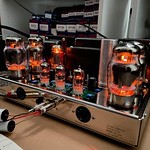 by rjpjnk Thu Jul 26, 2018 12:16 am
by rjpjnk Thu Jul 26, 2018 12:16 am
j beede wrote:I suspect this topic is being underthought (if such a word exists).
Some random thoughts in no particular order:
-Clipping is easily detected when the input signal is of the form y=Asin(wt+φ). This time domain.
-The spectral content of an ideal sine wave is single frequency, there are no harmonics in the frequency domain.
-The spectral content of a clipped sine wave includes odd (and potentially even) harmonics.
-The spectral content of a transient or impulse includes multiple frequencies, the narrower the pulse, the wider the range of frequencies in the spectral content.
My personal experience with using a preamp versus "running straight in" surprised me. The result of an A/B comparison was that the preamp configuration sounded fine... but running straight in simply sounded wrong--in a subtractive sense. Everyone in the room, including me, expected running straight in with an ALPS stereo attenuator) to be better. Everyone in the room agreed that it wasn't even close. Running straight in was described as "broken".
Marantz CD63 (0dB)
PAS 2 preamp v ALPS 100KAX2
Dynaco MkIII
Quad ESL
Vocals and instruments sounded fine with or without the preamp. Transients (e.g. rim shots, knuckles rapping guitar soundboard, flamenco heel taps, non-standard percussion (ACopeland, et al) were not correctly re-produced when running straight in.
My hypothesis is that the spectral content will help explain the difference. My LCD 'scope does fast Fourier transforms. I will start looking for a programmable waveform generator to download.
I suggest you buy or borrow a preamp if you are without. Discussing this topic without having experienced familiar music played both ways is limiting.
Thank you for this post jbeede. I was beginning to think I was the only one in the world seeking some manner of technical explanation for why premps improve sound. I hope you get some resolution in your spectral analysis approach. I look forward to reading about anything you discover.
Your experimental testing of pre vs direct sounds like exactly the kind of test I would do. I like that you approached it with the mentality that it has no reason to sound better, but it did. That makes the outcome all the more believable.
I wish I could borrow a preamp from a friend, but I don't know of anyone with a preamp locally. I am looking at a used PAS 3x now (about 500.00) or possibly the VTA SP9 (about 1000.00), but these both seem a little expensive just to "try". Still, I agree it is really the only way I can get the experience you describe of A/B-ing the direct vs preamp approach so that I can see for myself the magical difference these marvelous boxes can make.
I don't really mind if I never discover what makes the preamp improve the sound, but it would be more satisfying if I could. I suspect you feel similarly based on your experiments and obvious technical inclination. I suppose in a way it may be like asking for a technical explanation as to why one cello sounds better than another. There is nothing we can measure, it simply does. Or rather I should say, we do not understand what we should measure in order to discern the difference. But our ears tell us one is better.
How do you like the PAS2 you listed? Is it all stock? That seems like it might be the easiest first step to get in the game.
Thanks again.



 peterh
peterh

